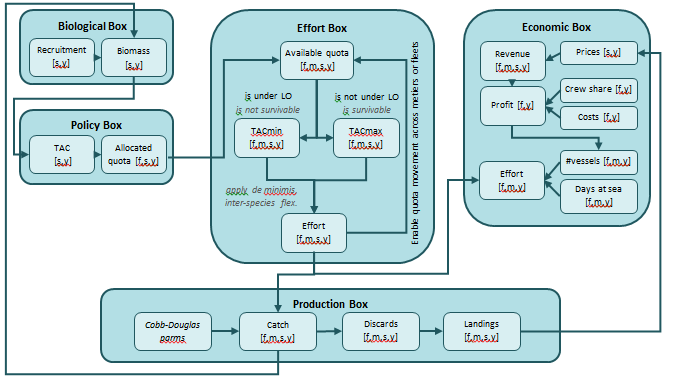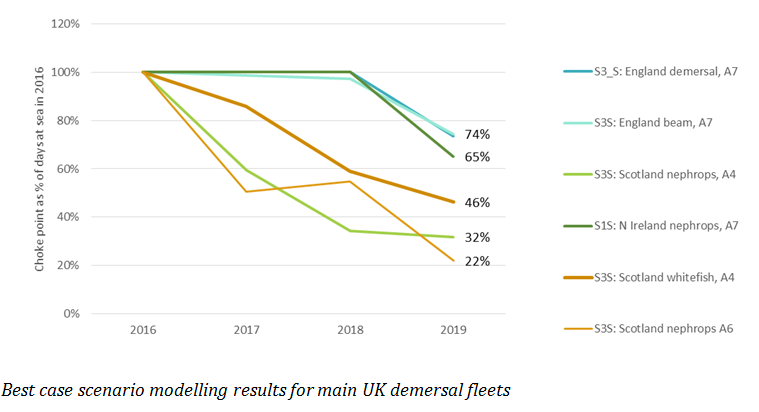

UK mixed demersal fishery
There were 4607 active boats in UK fishing fleet in 2016. The weight of fish landed by the fleet in 2016 was around 700 thousand tonnes or 1.1 billion euros. Most of UK vessels operate around the coast within UK economic zone (ICES subarea 4, 6 and 7). UK vessels target three different groups of species: pelagic, demersal and shellfish. For this specific analysis only demersal fleets and species have been analysed to show relevant impact of choke species on UK fishing fleets.
Model used
The model consists of 3 major structural parts: Data Input Framework; Bio-economic simulations and Data Output Framework. All parts are connected through the standard data flow and developed in R and VBA programming languages, which makes data input and results updatable when new data sets are published. The main advantages of the model is utilisation of information available from administrative and other institutional data sources (e.g. STECF FDI data base, ICES stock assessment, EU FIDES database, etc.) at lowest aggregation level available and incorporation of metier approach to economic fleet segments analysis, thus allowing to link economic performance indicators with activity information and gear use by area.
The model is the most extensive for the UK fleet with regards to coverage: covering around 100 UK fleet segments (defined on the level of UK home administration, PO and fishing technique); 400-600 metiers (defined through the combination of 10 ICES fishing areas and 9 main fishing gears) and 72 stocks. The model has been updated 3 times and has 2015, 2016 and 2017 baseline year’s versions.

SEAFISH model description
In the bio-economic simulations part there are five modules linked together to provide a yearly analysis, these are indicated in the figure including the dimensions of PO fleet segment (f), metier (m), stock (s) and year (y) as applied in the model.
Conclusion :
The analysis produced for DiscardLess project suggest that there will be certain choke risks for the UK demersal fishery due to difference between quota level available through national quota allocations, historical TAC allocations and catch compositions of individual fleets. All work done using the SEAFISH model showed that choke risks are significant for bycatch species, which are not targeted by fleets and therefore the UK does not always have enough quota.
Some choke risk mitigation measures might help to reduce these choke problems; however, the scale of change should be extended to other not modelled measures, e.g. real time closures, avoidance, seasonal closures and other. Only combination of all different measures might help to avoid fishing closure before the end of the year.

Economic consequences were not fully analysed in this project, as main driver of negative economic results is lack of quota for choke species. However, in case of fleets activity adaptation (e.g. use of seasonal area closures, avoidance) and removal of choke risks through combination of mitigation measures (e.g. selectivity in combination with quota trade and avoidance) there might be positive biological and economic results, which could lead to improvement of economic performance in a long term.
See also
Mardle S., Russel J., Motova A. (2017). Seafish Bioeconomic Modelling – Methodology Report. Seafish Report No. SR702, ISBN No 978-1-911073-08-6. https://www.seafish.org/media/Publications/Seafish_Bioeconomic_Methodology_Report_FINAL.pdf
Russell J., Mardle S., Motova A. (2017). Seafish Bioeconomic Modelling - Analysis of Choke Points and Problem Stocks for UK Fleet under the Landing Obligation, 2017-2019., Seafish Report No SR703, ISBN No 978-1-911073-09-3. https://www.seafish.org/media/Publications/Seafish_Bioeconomic_Choke_Report_FINAL.pdf
Catchpole T., Motova A, Radford Z., Mardle S (2017). UK Landing Obligation Analysis - Joint Seafish and Cefas analysis of the implications of the Landing Obligation for UK fishing fleets, Cefas&Seafish report
Citation :
Fiche UK mixed demersal fishery, Author(s) :
Arina Motova, SEAFISH
DiscardLess (2019) : Bioeconomic models to analyse LO effects